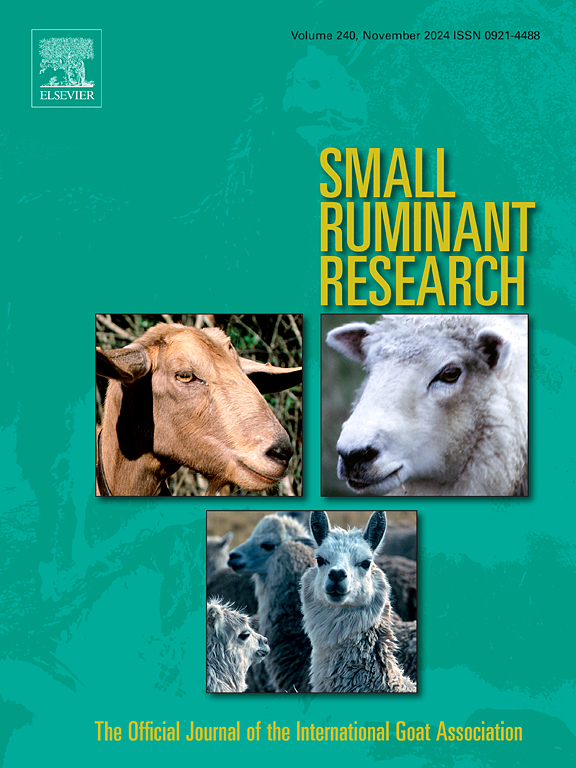绵羊脂肪性状的遗传分析及其NR1H4基因多态性与尾部脂肪沉积的关系
IF 1.6
3区 农林科学
Q2 AGRICULTURE, DAIRY & ANIMAL SCIENCE
引用次数: 0
摘要
以前羊尾脂肪提供了保暖和能量,但现在过多的脂肪损害了它们的健康和生产性能,影响了它们的经济价值。本研究分析了脂肪性状与其遗传性状之间的相关性。此外,还研究了nr1h4g . 182138945 T >; A变异对绵羊脂肪沉积的影响。表型相关表明,尾脂肪、肾周脂肪和肠系膜脂肪重与胴体脂肪含量呈显著正相关。尾脂肪相对重(相对于宰前胴体重或活重)与眼肌面积呈负相关,而肾周脂肪和肠系膜脂肪相对重(相对于宰前胴体重或活重)与眼肌面积呈低正相关。从遗传上看,肌内脂肪的遗传力低于大多数脂肪性状,而胴体脂肪含量的遗传力较高。尾脂肪重、胴体脂肪含量和肌内脂肪呈显著正相关。肾周脂肪质量与肠系膜脂肪质量也有显著正相关。眼肌面积与尾脂肪相对重量(相对于屠宰前胴体重或活重)呈遗传负相关。NR1H4 g.182138945 T >; 与脂肪沉积性状的相关性表明,该SNP与尾脂肪重及其相对重(屠宰前相对于胴体重或活体重)显著相关(P <; 0.05)。NR1H4在肝脏中表达水平最高,可能通过调节能量消耗影响绵羊尾部脂肪的沉积。该SNP可能是绵羊尾部脂肪改善的潜在标记。本文章由计算机程序翻译,如有差异,请以英文原文为准。
Genetic estimation of fat traits in sheep and association of its NR1H4 gene polymorphisms with tail fat deposition
Previously sheep tail fat provided warmth and energy, but now excessive fat harms their health and performance, affecting their economic value. This study analysed the correlation between fat traits and their genetic characteristics. As well, the effect of the NR1H4 g. 182138945 T > A variant on fat deposition in sheep was investigated. Phenotypic correlations showed significant positive correlations between tail fat, perirenal fat and mesenteric fat weights and carcass fat content. The relative weight of tail fat (relative to either carcass weight or live weight before slaughter) negatively correlates with eye muscle area, while those of the relative weights of perirenal fat and mesenteric fat (relative to either carcass weight or live weight before slaughter) show low positive correlations with eye muscle area. Genetically, intramuscular fat had lower heritability compared to most fat traits, while the carcass fat content had higher heritabilities. A significant positive genetic correlation existed between the tail fat weight, carcass fat content, and intramuscular fat. There was also a significant positive correlation between perirenal fat weight and mesenteric fat weight. Eye muscle area is genetically negatively correlated with the relative weight of tail fat (relative to either carcass weight or live weight before slaughter). The NR1H4 g.182138945 T > A association with fat deposition traits showed that the SNP was significantly (P < 0.05) associated with tail fat weight and its relative weight (relative to either carcass weight or live weight before slaughter). The highest levels of NR1H4 were expressed in liver, which may affect the deposition of fat in the tail of sheep by regulating energy expenditure. This SNP could be a potential marker for tail fat improvement in sheep.
求助全文
通过发布文献求助,成功后即可免费获取论文全文。
去求助
来源期刊

Small Ruminant Research
农林科学-奶制品与动物科学
CiteScore
3.10
自引率
11.10%
发文量
210
审稿时长
12.5 weeks
期刊介绍:
Small Ruminant Research publishes original, basic and applied research articles, technical notes, and review articles on research relating to goats, sheep, deer, the New World camelids llama, alpaca, vicuna and guanaco, and the Old World camels.
Topics covered include nutrition, physiology, anatomy, genetics, microbiology, ethology, product technology, socio-economics, management, sustainability and environment, veterinary medicine and husbandry engineering.
 求助内容:
求助内容: 应助结果提醒方式:
应助结果提醒方式:


